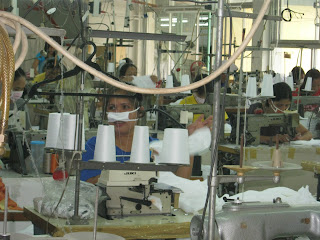This past Monday we were lucky enough to have been asked to join a Barangay health workers graduation ceremony in Antipolo. The graduation took place in an outdoor community hall. Those in attendance included a Dr. from Chicago that works in partnership with UERM, the community midwife, barangay health workers and the ceremony was conducted by the junior residents of UERM. This was a very exciting time for both the barangay health workers graduating and for the community. The graduates consist of members of the local community who were interested in helping their community and therefore chose to become health care volunteers. They then went through six months of training to learn assessment skills such as taking vital signs and health teaching about common illnesses such as colds, fevers, and diarrhea. Since there is a lack of nurses, doctors and midwives especially in remote neighbourhood’s barangay health workers fill a gap in the delivery of health care and become one of the most valued members of the health care team focusing on Primary Health Care. The graduation ceremonies consisted of introductions, speeches and the presentation of the graduation certificates. The health care workers then presented a dance they had worked on. After it was time for a snack and picture taking. It was a very interesting event and we could really see how the community works together for the good of its people. That afternoon we were off to UERM for orientation. The eight students staying for their acute practicum received their hospital orientation while the other four met their buddies and learned what they would be doing in the community for the week. Both groups had an opportunity to take a tour of the hospital at UERM. There are two types of hospitals in the Philippines, private and government/charity. The hospital at UERM is classified as both a private and public hospital because it is affiliated with the university. If a patient is able to pay for the medical services needed then they will be placed on the private side. However, if for some reason the patient is unable to afford the price of treatment they will be placed on the public side where the government pays for the bed and the doctors but the patient is still responsible for paying for any medicine and tests they may need. We learned from our Filipino buddies that it is common for patients on the public side to attempt to leave without paying the bill for services during their stay and if this occurs it is the nurse that is responsible for paying the bill for any medication that she/he administers. After the tour we were invited to an alumni supper were we were treated to good food and entertainment.
Tuesday morning we went into the community to perform assessments involved in the Integrated Management of Childhood Illnesses (IMCI). We assessed a couple children with coughs and colds and identified 3 children with Tuberculosis. After lunch we all sat down to discuss subjects to talk about with the community members on Wednesday afternoon at our focus group. We then surveyed a couple houses with regards to a major health problem in the community which we were able to identify as hypertension.
Wednesday we once again had the opportunity to practice giving immunizations through the Expanded Program of Immunizations (EPI) at two health units in the community. In the afternoon we conducted our focus group were we gathered community members together and discussed what they felt were some of the major health issues in the community. We also enquired about what we could do to help them become empowered to engage in a healthier lifestyle and ultimately reduce the prevalence of health problems such as hypertension. Through our discussion we identified that they were interested in learning more about healthier food choices that they could make and exercise activities that they could perform during their daily routine that did not involve making a commitment to organized activity because most are unable to leave their stores which for many is their only source of income.
Thursday morning we went to the Broadway Health Center where we were able to help with prenatal assessments. We assessed 4 mothers by performing Leopalds Maneouvers and listening for the fetal heart beat. In the afternoon we planned for our implementation of health teaching regarding an appropriate diet and exercise routine for a person with hypertension that we will be delivering to the members of the community on Friday morning. Following this planning session we went back out into the community to perform the Metro Manila Development Screening Tool (MMDST) which is an assessment tool used to screen for developmental delays in children under the age of five. It is an adaptation of the Denver Screening Tool used for assessing children in Canada and the United States. We were able to assist with the assessment of a four year old girl who we had encountered earlier in the week during our home visits. We were informed by her aunt that the child has not spoken since birth. We concluded that the child was within normal limits in all categories except that of language and we were able to inform her mother that it would be beneficial to have a referral to a speech therapist. The mother was very receptive to our suggestions and it was a good way to end off the day.































